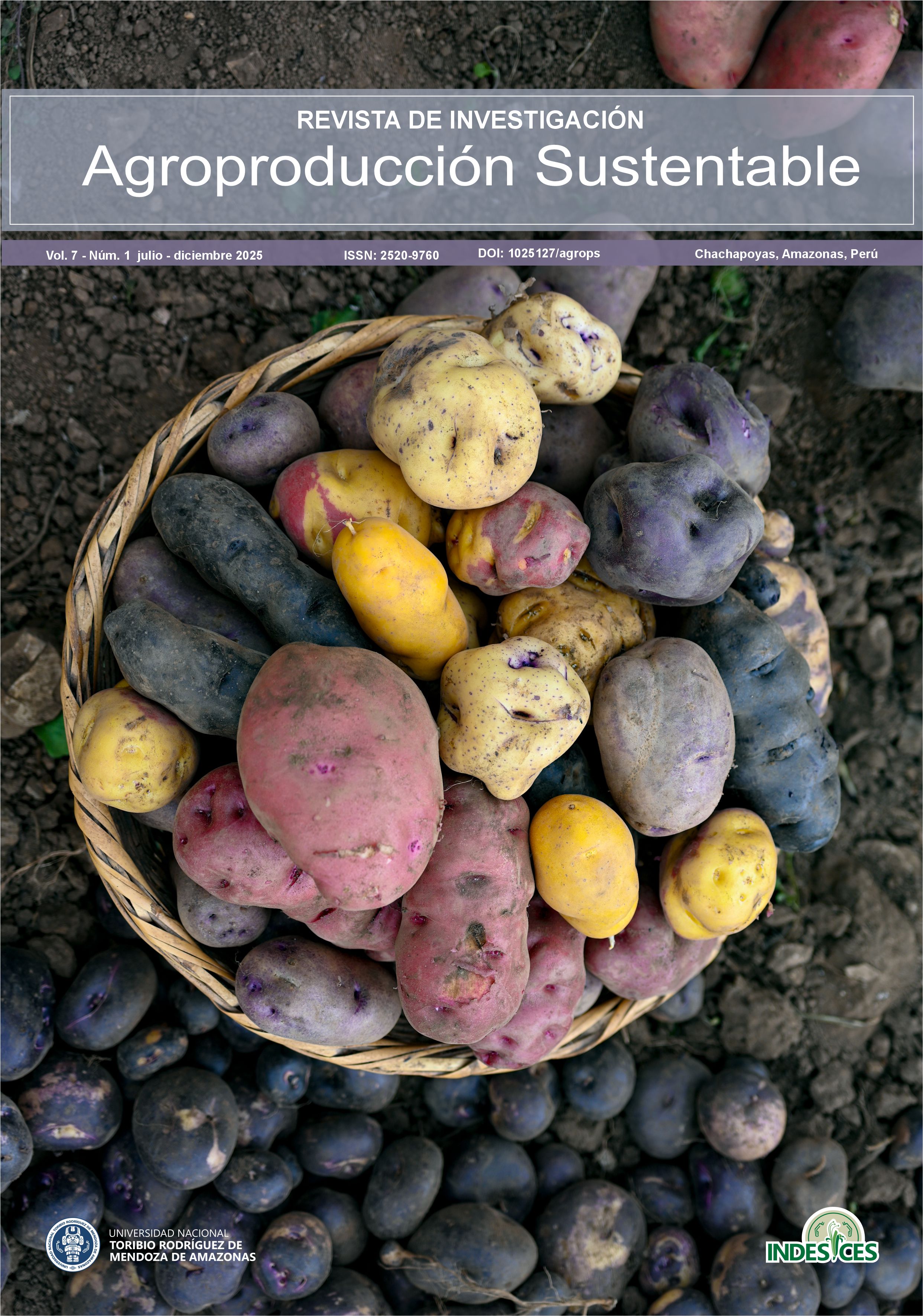Synergies between microorganisms and mineral fertilization in potato seed quality (Solanum tuberosum L.)
DOI:
https://doi.org/10.25127/agrops.20251.1122Keywords:
Solanum tuberosum L, Bacillus subtilis, Trichoderma viride, rendimiento, semillaAbstract
Soil microorganisms hold considerable promise for the development of integrated, sustainable agricultural systems. Potato (Solanum tuberosum L.) crop productivity requires nutritional strategies that optimize yield without affecting seed commercial quality. In this context, the application of specific microorganisms that improve nutrient availability and crop physiological performance represents a sustainable strategy. This study evaluated the effect of organo-mineral fertilization and inoculation with Trichoderma viride and Bacillus subtilis on seed yield and commercial quality of tubers in two potato varieties (INIA 303- Canchán and Yungay) under the agroecological conditions of the Peruvian Andes. A completely randomized design (CRD) with a 3x3x2 factorial arrangement and three replications per treatment was used, totaling 54 DUs. Three fertilization levels (0%, 50%, and 100% NPK) and three levels of microorganisms (no microorganisms, Trichoderma, Bacillus) and two potato cultivars were evaluated. Robust ANOVA (WRS2) and Sidak’s test (α = 0.05) were applied. Tuber weight per plant was higher with complete fertilization and microorganisms: m1×n3 = 2.043±0.13kg; m2×n3 = 1.928±0.13kg. The Yungay variety outperformed Canchán in all categories, with higher first-grade seed production: 21.8±1.48kg vs. 15.7±1.48kg, reaching a maximum of 27.0±3.14kg in m3×n3. No significant differences were found between treatments for PC2 and PC3 seed weights; However, there was a difference between the Yungay (PC2: 18.2±1.08kg; PC3: 13.7±0.81kg) and INIA 303-Canchán (PC2: 13.4±1.08kg; PC3: 10.7±0.81kg) varieties. It is concluded that the integration of PGPM with chemical fertility improves seed yield and quality, promoting sustainable agricultural systems in Ayacucho.
Downloads
Published
Issue
Section
License
Copyright (c) 2025 Miguel Luis Tueros Munive, Melina Luz Vilcapoma Paliza, Guido Bryan Pillaca Chillcce, José Velásquez, Henry Campos, Omar Paitamala, Daniel Matsusaka

This work is licensed under a Creative Commons Attribution-NonCommercial-ShareAlike 4.0 International License.
Aquellos autores/as que tengan publicaciones con esta revista, aceptan los términos siguientes:
- Los autores/as conservarán sus derechos de autor y garantizarán a la revista el derecho de primera publicación de su obra, el cuál estará simultáneamente sujeto a la Licencia de reconocimiento de Creative Commons. Por tanto:
Usted es libre de:
- Compartir — copiar y redistribuir el material en cualquier medio o formato
- Adaptar — remezclar, transformar y construir a partir del material
- La licenciante no puede revocar estas libertades en tanto usted siga los términos de la licencia
Bajo los siguientes términos:
Atribución — Usted debe dar crédito de manera adecuada, brindar un enlace a la licencia, e indicar si se han realizado cambios. Puede hacerlo en cualquier forma razonable, pero no de forma tal que sugiera que usted o su uso tienen el apoyo de la licenciante.
NoComercial — Usted no puede hacer uso del material con propósitos comerciales.
CompartirIgual — Si remezcla, transforma o crea a partir del material, debe distribuir su contribución bajo la lamisma licencia del original.
- No hay restricciones adicionales — No puede aplicar términos legales ni medidas tecnológicas que restrinjan legalmente a otras a hacer cualquier uso permitido por la licencia.
- Los autores/as podrán adoptar otros acuerdos de licencia no exclusiva de distribución de la versión de la obra publicada (p. ej.: depositarla en un archivo telemático institucional o publicarla en un volumen monográfico) siempre que se indique la publicación inicial en esta revista.
- Se permite y recomienda a los autores/as difundir su obra a través de Internet (p. ej.: en archivos telemáticos institucionales o en su página web) antes y durante el proceso de envío, lo cual puede producir intercambios interesantes y aumentar las citas de la obra publicada. (Véase El efecto del acceso abierto).

Esta obra está bajo una Licencia Creative Commons Atribución-NoComercial-CompartirIgual 4.0 Internacional


